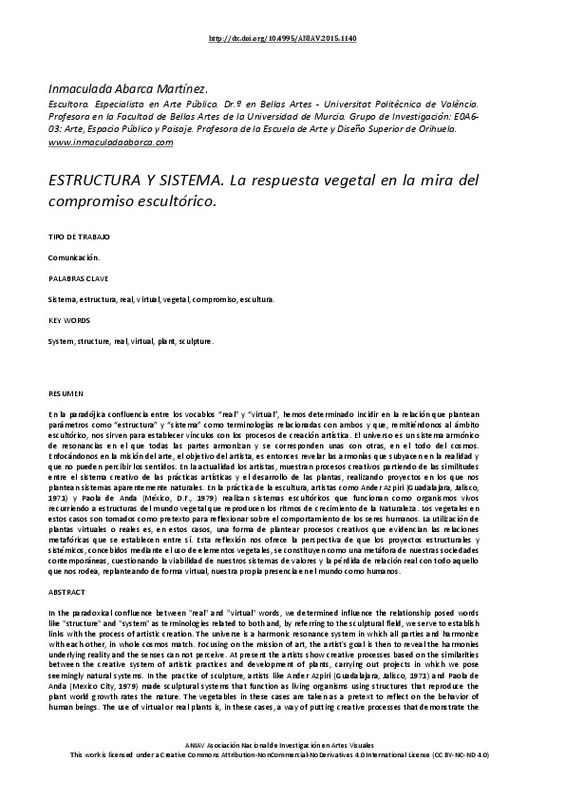JavaScript is disabled for your browser. Some features of this site may not work without it.
Buscar en RiuNet
Listar
Mi cuenta
Estadísticas
Ayuda RiuNet
Admin. UPV
ESTRUCTURA Y SISTEMA. La respuesta vegetal en la mira del compromiso escultórico
Mostrar el registro sencillo del ítem
Ficheros en el ítem
| dc.contributor.author | Abarca Martínez, Inmaculada
|
es_ES |
| dc.date.accessioned | 2018-02-15T08:17:36Z | |
| dc.date.available | 2018-02-15T08:17:36Z | |
| dc.date.issued | 2015-11-26 | |
| dc.identifier.isbn | 9788490483411 | |
| dc.identifier.uri | http://hdl.handle.net/10251/97943 | |
| dc.description.abstract | [EN] In the paradoxical confluence between "real" and "virtual" words, we determined influence the relationship posed words like "structure" and "system" as terminologies related to both and, by referring to the sculptural field, we serve to establish links with the process of artistic creation. The universe is a harmonic resonance system in which all parties and harmonize with each other, in whole cosmos match. Focusing on the mission of art, the artist's goal is then to reveal the harmonies underlying reality and the senses can not perceive. At present the artists show creative processes based on the similarities between the creative system of artistic practices and development of plants, carrying out projects in which we pose seemingly natural systems. In the practice of sculpture, artists like Ander Azpiri (Guadalajara, Jalisco, 1971) and Paola de Anda (Mexico City, 1979) made sculptural systems that function as living organisms using structures that reproduce the plant world growth rates the nature. The vegetables in these cases are taken as a pretext to reflect on the behavior of human beings. The use of virtual or real plants is, in these cases, a way of putting creative processes that demonstrate the metaphorical relationships established among themselves. This reflection offers the prospect of structural and systemic projects, designed by using plant elements, constitute a metaphor of our contemporary societies, questioning the viability of our value systems and loss of real relationship with all that around us, rethinking virtually, our own presence in the world as humans. | es_ES |
| dc.description.abstract | [ES] En la paradójica confluencia entre los vocablos “real” y “virtual”, hemos determinado incidir en la relación que plantean términos como “estructura” y “sistema” como terminologías relacionadas con ambos y que, remitiéndonos al ámbito escultórico, nos sirven para establecer vínculos con los procesos de creación artística. El universo es un sistema armónico de resonancias en el que todas las partes armonizan y se corresponden unas con otras, en el todo del cosmos. Enfocándonos en la misión del arte, el objetivo del artista, es entonces revelar las armonías que subyacen en la realidad y que no pueden percibir los sentidos. En la actualidad los artistas, muestran procesos creativos partiendo de las similitudes entre el sistema creativo de las prácticas artísticas y el desarrollo de las plantas, realizando proyectos en los que nos plantean sistemas aparentemente naturales. En la práctica de la escultura, artistas como Ander Azpiri (Guadalajara, Jalisco, 1971) y Paola de Anda (México, D.F., 1979) realizan sistemas escultóricos que funcionan como organismos vivos recurriendo a estructuras del mundo vegetal que reproducen los ritmos de crecimiento de la Naturaleza. Los vegetales en estos casos son tomados como pretexto para reflexionar sobre el comportamiento de los seres humanos. La utilización de plantas virtuales o reales, es en estos casos, una forma de plantear procesos creativos que evidencian las relaciones metafóricas que se establecen entre sí. Esta reflexión nos ofrece la perspectiva de que los proyectos estructurales y sistémicos, concebidos mediante el uso de elementos vegetales, se constituyen como una metáfora de nuestras sociedades contemporáneas, cuestionando la viabilidad de nuestros sistemas de valores y la pérdida de relación real con todo aquello que nos rodea, replanteando de forma virtual, nuestra propia presencia en el mundo como humanos. | es_ES |
| dc.format.extent | 8 | es_ES |
| dc.language | Español | es_ES |
| dc.publisher | Editorial Universitat Politècnica de València | es_ES |
| dc.relation.ispartof | II CONGRESO INTERNACIONAL DE INVESTIGACIÓN EN ARTE VISUALES | es_ES |
| dc.rights | Reconocimiento - No comercial - Sin obra derivada (by-nc-nd) | es_ES |
| dc.subject | Sistema | es_ES |
| dc.subject | Estructura | es_ES |
| dc.subject | Real | es_ES |
| dc.subject | Virtual | es_ES |
| dc.subject | Vegetal | es_ES |
| dc.subject | Compromiso | es_ES |
| dc.subject | Escultura | es_ES |
| dc.title | ESTRUCTURA Y SISTEMA. La respuesta vegetal en la mira del compromiso escultórico | es_ES |
| dc.type | Capítulo de libro | es_ES |
| dc.type | Comunicación en congreso | es_ES |
| dc.identifier.doi | 10.4995/ANIAV.2015.1140 | |
| dc.rights.accessRights | Abierto | es_ES |
| dc.description.bibliographicCitation | Abarca Martínez, I. (2015). ESTRUCTURA Y SISTEMA. La respuesta vegetal en la mira del compromiso escultórico. En II CONGRESO INTERNACIONAL DE INVESTIGACIÓN EN ARTE VISUALES. Editorial Universitat Politècnica de València. 44-51. https://doi.org/10.4995/ANIAV.2015.1140 | es_ES |
| dc.description.accrualMethod | OCS | es_ES |
| dc.relation.conferencename | II Congreso Internacional de Investigación en Artes Visuales. |< real | virtual >| ANIAV2015 | es_ES |
| dc.relation.conferencedate | July 09-10,2015 | es_ES |
| dc.relation.conferenceplace | Valencia, Spain | es_ES |
| dc.relation.publisherversion | http://ocs.editorial.upv.es/index.php/ANIAV/ANIAV2015/paper/view/1140 | es_ES |
| dc.description.upvformatpinicio | 44 | es_ES |
| dc.description.upvformatpfin | 51 | es_ES |
| dc.type.version | info:eu-repo/semantics/publishedVersion | es_ES |
| dc.relation.pasarela | OCS\1140 | es_ES |








